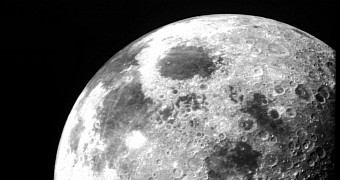A study recently published in the journal Proceedings of the National Academy of Sciences offers a new explanation for a decades-old puzzle: how and why the soil covering the surface of the Moon ended up containing water in its makeup.
Thus, authors Alice Stephant and François Robert argue that, according to evidence at hand, the water documented on the surface of the Moon is the lovechild of protons found in solar wind and oxygen present in lunar dust.
Admittedly, some of the water on our planet's satellite likely got there following comet or meteorite impacts. Still, the scientists maintain that it was solar wind and lunar dust that birthed most of it.
When solar wind romances lunar dust
In their paper, the Sorbonne Universités and Muséum National d'Histoire Naturelle specialists explain that, as part of their investigation, they studied the makeup of several teeny tiny grains of lunar soil collected from the surface of the Moon.
As detailed by Phys Org, the scientists argue that most of the water found in these samples almost certainly formed when protons from solar wind acted on oxygen from silicates in the lunar surface soil, reducing it.
“The external flux of particles and solid materials that reach the surface of the airless Moon constitute a hydrogen (H) surface reservoir that can be converted to water (or OH) during proton implantation in rocks,” Alice Stephant and François Robert write.
It is understood that, of the lunar surface soil samples analyzed as part of this research project into the makeup of our Moon, the majority were found to contain about 75% water resulting from interactions between solar wind and dust.
This is yet to be confirmed, but Alice Stephant and François Robert believe that the remaining 25% originated from comet or meteorite impacts. Interestingly enough, the researchers also found some samples containing just water birthed by protons in solar wind and oxygen in lunar dust.
The makeup of the Moon is still a mystery
As mentioned, the samples analyzed as part of this investigation were all collected from the surface of the Moon. This means that, although science appears to have found an explanation for the presence of water in the soil covering this satellite, plenty other questions remained unanswered.
Thus, researchers are yet to determine how and why the Moon ended up packing water right beneath its surface in some places. It could be that this water was brought here by celestial objects that collided with the moon. Then again, it is also possible that it was birthed by local reactions. Hopefully, future investigations will solve this puzzle.

 14 DAY TRIAL //
14 DAY TRIAL //